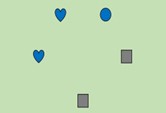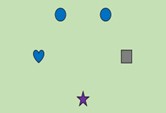L1 Korean speakers' definiteness processing in L2 English: A visual world paradigm eye-tracking study
In conducting studies on the L2 processing of English articles (Ahn, 2021; 2022), I found it important to separate the linguistic information (definitness) from any other sources of information (e.g., real-world knowledge) so as to make arguments only about L2 speakers' acquisition and use of the grammatical knowledge of definiteness. In this study (accepted manuscript available here if you don't have access to Bilingualism-Language and Cognition), my co-author and I used a visual-world paradigm eye-tracking expeirment to observe L2 speakers' eye-gaze movements as they heard sentences such as "Click on the blue circle" or "Click on a blue circle" along with the visual stimuli as below.


As you can imagine, one will find it felicitous when Figure A goes with the sentence with the definite NP (the blue circle) and Figure B with the indefinite one (a blue circle). Based on the assumption, we predicted that fixations will be faster and higher in the felicitous conditions than in the infelicitous conditions. The study confirmed our prediction regarding the definite NP in the one-target condition. As for the indefinite NP in the two-target condition, findings from the previous studies (that indefinite NPs do not necessarily refer to non-unique referents in Ahn, 2021; 2022) were confirmed again. Below are the graphs that show the eye movement patterns of L1, advanced L2, and intermediate L2 speakers.

